#Villa romana del casale
Text

The bedroom of the guest suite. It has an, um, interesting center mosaic.
Villa Romana del Casale
Piazza Armerina, Sicily
#ancient rome#ancient roman#mosaic#sicily#sicilia#villa romana del casale#Piazza Armerina#italy#italia#lensblr#photography#travel#original photography#photographers on tumblr#architecture#historical architecture#ancient architecture#ancient art#roman archaeology#roman architecture#archaeology#roman art#interiordecor#wanderingjana
43 notes
·
View notes
Text
I think tumblr girlies need to see fabulous Roman girlies having fun.
30 notes
·
View notes
Text






A day well spent staring at the beautiful details of the mosaics at Villa Romana del Casale.
10 notes
·
View notes
Text



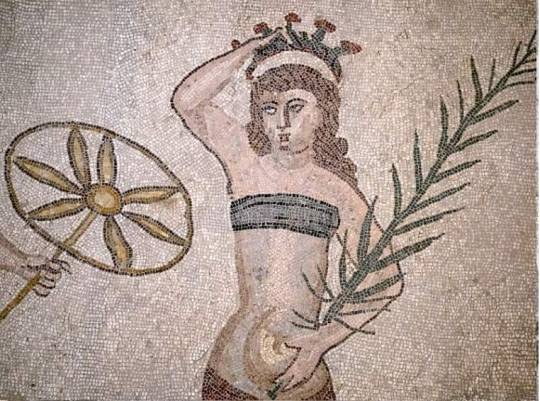
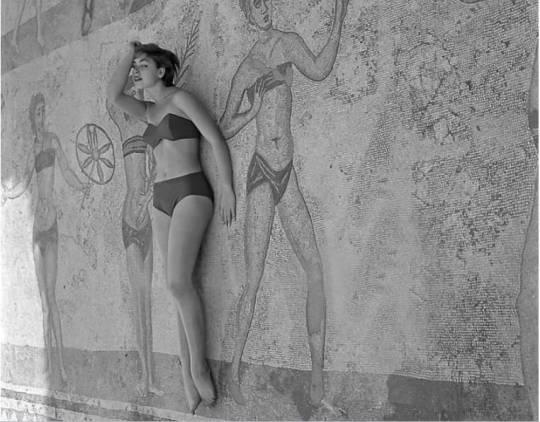
In 1956, Emilio Pucci (a famous Italian fashion designer) designed the bikini, inspired by the Roman mosaics at Villa Romana del Casale in Sicily 🇮🇹
Villa Romana del Casale is an ancient Roman estate in Sicily, famous for its stunning mosaics. One of the most famous mosaics depicts girls playing sports, dressed in outfits reminiscent of modern bikinis.
This mosaic is important evidence that this kind of swimsuit existed long before the 20th century.
📷 Archivio Emilio Pucci
#emilio pucci#italian design#villa romana del casale#sicily#italia#italy#bikini#one piece#two piece#swimwear#repost
3 notes
·
View notes
Text

Ancient Roman Mosaic Reveals Women Wore Bikini
It is believed that the bikini was a 20th century invention, but an ancient mosaic reveals women in Rome wore it while playing sports.
The Villa Romana del Casale, located in Sicily, dates back to the early fourth century AD. Among the ruins, archeologists have discovered one of the largest collections of ancient Roman mosaics.
All of them are surprisingly well preserved. One of the rooms of the villa is called Sala delle Dieci Ragazze, which can be translated as “Room of the Ten Girls” – based on the number of those depicted in the floor mosaic.
Eight of them wear what in the modern world would be called a two-piece bikini, another woman wears a yellow translucent dress, while the image of the only one figure has not survived to this day.
The bottom of this set of clothing looks like a terracotta-colored band made of fabric or leather, similar to men’s loincloths. As for the top, it is reminiscent of a modern strapless breastband. Such chest harnesses also have their own history and have been known since the times of Ancient Greece. It is believed that most often the material for this was linen. This piece of clothing was intended for women leading an active lifestyle and partaking in physical exercise.
Thus, it can be assumed that in ancient times such a bikini was not used for swimming, but rather for sports. This is exactly what all the women depicted in the mosaic are doing. Some of them run, and others throw a discus or hold weights in their hands.
Two women are playing with a ball together. Researchers speculate that this could be some kind of early form of volleyball. In general, ball games are considered one of the most ancient. Their mentions can be found in Homer’s Odyssey. One of the girls, standing in the center, holds a palm branch in one hand and is about to place a victory crown on her head – probably a reward for the best performance. All the women look athletic and have noticeable muscle outlines on their arms and legs.
When it comes to sports, women in ancient Rome were permitted to practice physical forms of exercise, but they faced certain restrictions within a patriarchal society. They were not allowed to take part in competitions with men, and public female nudity was frowned upon. Therefore, a kind of prototype of the modern bikini made it possible to play sports without much inconvenience.
By Maria Rybachuk.
#Ancient Roman Mosaic Reveals Women Wore Bikini#Roman Bikini Girls#Room of the Ten Girls#mosaic#roman mosaic#The Villa Romana del Casale#sicily italy#ancient artifacts#archeology#archeolgst#history#history news#ancient history#ancient culture#ancient civilizations#roman history#roman empire#roman art
121 notes
·
View notes
Text
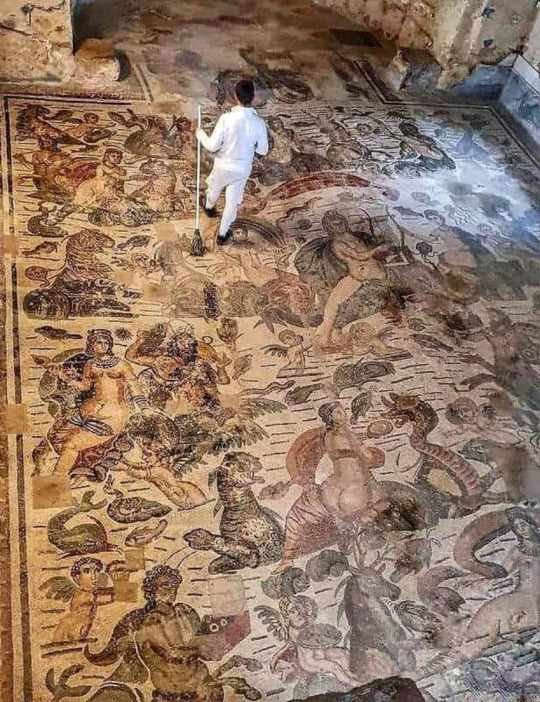
Ancient Roman mosaic floor at Villa Romana del Casale, Sicily, Italy, depicts mythical creatures and characters from Greek mythology.
4K notes
·
View notes
Text
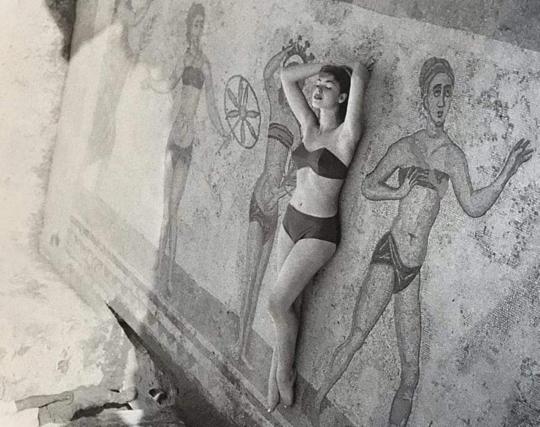
1956, Emilio Pucci designed a bikini, inspired by the Roman mosaics of the Villa Romana del Casale (4th century AD) in Sicily, Italy.
255 notes
·
View notes
Text

Emilio Pucci designed a bikini, 1956, inspired by the Roman mosaics of the Villa Romana del Casale (4th century AD) in Sicily, Italy.
148 notes
·
View notes
Photo

Villa Romana del Casale - Piazza Armerina, Enna, Sicilia, Italia.
804 notes
·
View notes
Text



"Marquis Emilio Pucci paid tribute to his Sicilian roots by having his models debut his bikinis atop the very mosaics that inspired them at the Villa Romana del Casale, a Roman villa built in the first quarter of the fourth century in Sicily." Spring / Summer 1955 Siciliana Collection • Villa Romana del Casale, Sicily • Elsa Haertter • Image courtesy of the Emilio Pucci Archive. Source: https://www.sarahaaronson.com/blog/tfh2955s035xqabn83pbnl6ixxqt0k
#queued for first day of summer#bikini#model#mosaic#roman art#roman history#emilio pucci#photography#1950s#italy#sicily#aesthetic#beauty#summer#vibes#beautiful#bikini model#fashion#fashion history#june
52 notes
·
View notes
Text

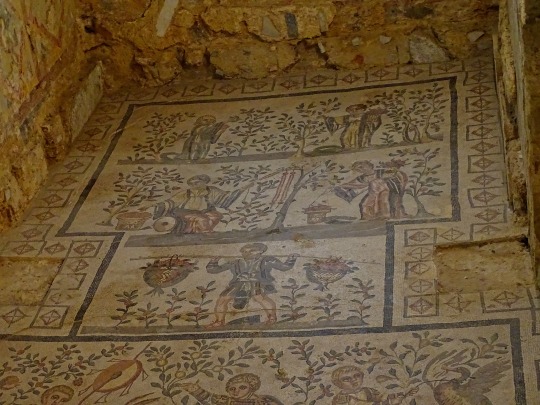
A floor mosaic found in the Villa Romana del Casale (often called Piazza Armerina), a 4th century Ancient Roman villa in Central Sicily. This villa has some of the best preserved in situ Roman mosaics in Italy.
Dec. 2019
#piazza armerina#ancient rome#ancient roman#ancient art#mosaic#art#italia#italy#original photography#photography#travel#photographers on tumblr#lensblr#architecture#historical architecture#villa#interior design#villa romana del casale#sicily#sicilia#wanderingjana
40 notes
·
View notes
Text

Magnificent Roman floor mosaic of the Villa Romana del casale in Piazza Armerina, Sicily, Italy.
99 notes
·
View notes
Text

MOSAICO DE LA VILLA ROMANA DEL CASALE
(Español / English)
La Villa Romana del Casale, situada en la pintoresca localidad siciliana de Piazza Armerina, es un tesoro arqueológico que data del IV siglo d.C. Esta villa romana tardía fue incluida en la lista del Patrimonio de la Humanidad por el UNESCO en 1997.
He aquí algunos detalles fascinantes sobre la historia de esta extraordinaria residencia:
Descubrimiento casual: En el siglo XVII, los campesinos que trabajaban en los campos del alto valle del río Gela, al pie del monte Mangone, notaron numerosas estructuras de pared que emergían del suelo. Estas revelaron entonces que pertenecieron a la grandiosa villa imperial del Casale. El entusiasmo por este hallazgo atrajo la atención de muchos eruditos locales.
Mosaicos excepcionales: La Villa Romana del Casale es famosa sobre todo por su extraordinaria colección de mosaicos, perfectamente conservados en el tiempo gracias a una capa de barro causada por una antigua inundación. Estos mosaicos decoran los pisos y representan escenas mitológicas, animales, juegos y actividades diarias. Son un verdadero espectáculo para los ojos y testimonian la riqueza y el gusto artístico de la época romana.
Estructura monumental: El chalet incluye Cubículos, Vestíbulos,Peristilos, Ambulacri, Triclini, Diaete, Acueductos, Latrine y Termas. La disposición en diferentes niveles recuerda el ejemplo de la villa del emperador Tiberio en Capri. La magnificencia de los mármoles, de las columnas y de los suelos de mosaico desafía incluso la morada de Diocleciano en Split.
La Villa Romana del Casale es un viaje al pasado, un lugar donde la historia y el arte se funden en una experiencia extraordinaria. Si alguna vez tienes la oportunidad de visitarla, te recomiendo admirar estos mosaicos únicos y sumergirte en la antigua grandeza de este lugar mágico.
------------------------------------------------------------------------------
MOSAIC OF THE ROMAN VILLA DEL CASALE
The Villa Romana del Casale, located in the picturesque Sicilian town of Piazza Armerina, is an archaeological treasure dating back to IV century AD. This late Roman villa has been listed as a World Heritage Site by UNESCO in 1997.
Here are some fascinating details about the history of this extraordinary residence:
Random discovery: In the XVII century, farmers working in the fields of the upper valley of the river Gela, at the foot of the mountain Mangone, noticed numerous wall structures emerging from the ground. They later revealed that they belonged to the grand imperial villa of the Casale. The enthusiasm for this discovery attracted the attention of many local scholars.
Exceptional mosaics: Villa Romana del Casale is famous for its extraordinary collection of mosaics, perfectly preserved over time thanks to a layer of mud caused by an ancient flood. These mosaics decorate the floors and represent mythological scenes, animals, games and daily activities. They are a real spectacle for the eyes and testify to the richness and artistic taste of the Roman period.
Monumental structure: The villa includes Cubicles, Vestibules, Peristili, Ambulatories, Triclini, Diaete, Aqueducts, Latrine, and Terme. The layout on different levels recalls the example of the Emperor’s villa Tiberius on Capri. The magnificence of the marbles, columns and mosaic floors defies even the abode of Diocletian in Split³.
The Villa Romana del Casale is a journey into the past, a place where history and art come together in an extraordinary experience. If you ever have the opportunity to visit it, I recommend that you admire these unique mosaics and immerse yourself in the ancient greatness of this magical place .
66 notes
·
View notes
Text

Unknown Roman mosaicist, Villa Romana del Casale: Mosaic Showing Female Athletes Competing for Prizes, ca. 300-325 CE, mosaic (Piazza Armerina, Sicily)


304 notes
·
View notes
Text

Two women appear to exercise (one with little dumbbells) in this mosaic from the Villa Romana del Casale, 300s CE. This is part of the so-called "Room of the Gymnasts," discovered around 1960, which shows women participating in a number of athletic activities.
{WHF} {Medium}
210 notes
·
View notes









